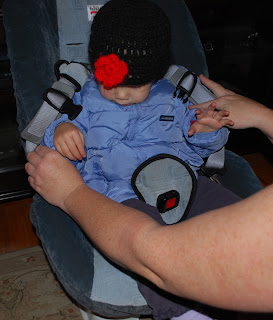This is the second in a series on car seat safety, written by Megan
Arce, CPST (Certified Child Passenger Safety
Technician) and mother to 2 little princesses. My daughter, Bethany,
introduced us and I was thrilled when she agreed to write this series
for me. So, for the next few weeks, make sure you check back in on
Thursdays for more important information all parents, and grandparents
and other caregivers, need to know to keep our precious little ones safe! *Note: GG is taking a break next week, so the third entry in this series will not be posted until January 3, 2013.
Several videos about the dangers of children wearing puffy
coats in car seats have been making their way through the social media, and for
this I am thrilled -- word is getting out about this danger! I am not seeing a lot of realistic alternatives for parents who live in a very cold climate,
however. Taking a child’s coat off
before buckling her into a car seat may actually sound like torture mid-winter!
There are several ways to keep your child comfortable AND safe in the car
though, I promise.
First, why are thick,
puffy, bulky winter coats not advised for use in a car seat? Basically, too much puff in a coat means too
much excess air in between the child and the harness. This air will compress in
a collision, and the child will likely suffer from internal injuries resulting
from slamming into the loose harness. A
puffy coat can create an ill-fitting harness, and can also mask a bad harness
fit (i.e. shoulder straps may not even be on the shoulders), and a child could be
completely ejected from the seat. Children can overheat quite quickly as well, especially in the car.
I conducted the following test on my daughter as a visual
reference of puffy coat danger:
and I snugly adjusted the harness (no excess material to
pinch). Even to my trained eye, she looks perfect:
2) Leaving the harness tight (unloosened/unchanged), I
unbuckled her, removed the puffy coat and returned her to the seat in only a
single layer shirt:
I repeated this test in a thin fleece jacket and the results
speak for themselves -- MUCH safer:
Another cold weather no-no is a bundle sack -- a fleece lined
pouch fits over the infant seat and almost completely cocoons baby inside.
These seem like a good, warm idea but these products: A) are not crash tested by
either the car seat manufacturer or the sack’s manufacturer, B) do not contain
flame-resistant material that a car seats does, and C) interfere with the
harness when attaching around and through it with Velcro, which could cause the
harness to fail. Most car seat manuals specify
that the use of ANY after market products is not approved by the car seat
manufacturer with the car seat, and therefore would void the owner’s warranty. These items are wonderful for use in strollers,
but not car seats!
So what you CAN do to keep a child warm in the car? A thin, single layer of fleece (as shown
above) is the best option, either hooded or add a hat. Thin fleece does not compress, and gives a
child a good warmth foundation. Blankets
can be added ON TOP of the harness as needed, and they can easily be removed if
the child becomes overheated. Using the
child’s puffy coat backwards, on top of the harness, is a safe option, as are Snuggie
blankets and ponchos (with the back lying up against car seat back, over
child’s head, not behind). These are all
safe, realistic options. The overall
goal is to keep as little excess space between the child and the harness as
possible.
With Christmas right around the corner, I felt it was a good
time to conduct a “puffy dress” test as well. Here is my oldest darling, donning a puffy
dress, harnessed snugly in a car seat:
And here is how much slack was actually in her harness after
removing the dress, but leaving the harness unaltered:
Please use caution with clothing and car seats- it is a far
more relevant danger than it seems!
“When you know better, you do better!”
Click here to read the first in the series -- Car seats and air travel











No comments:
Post a Comment